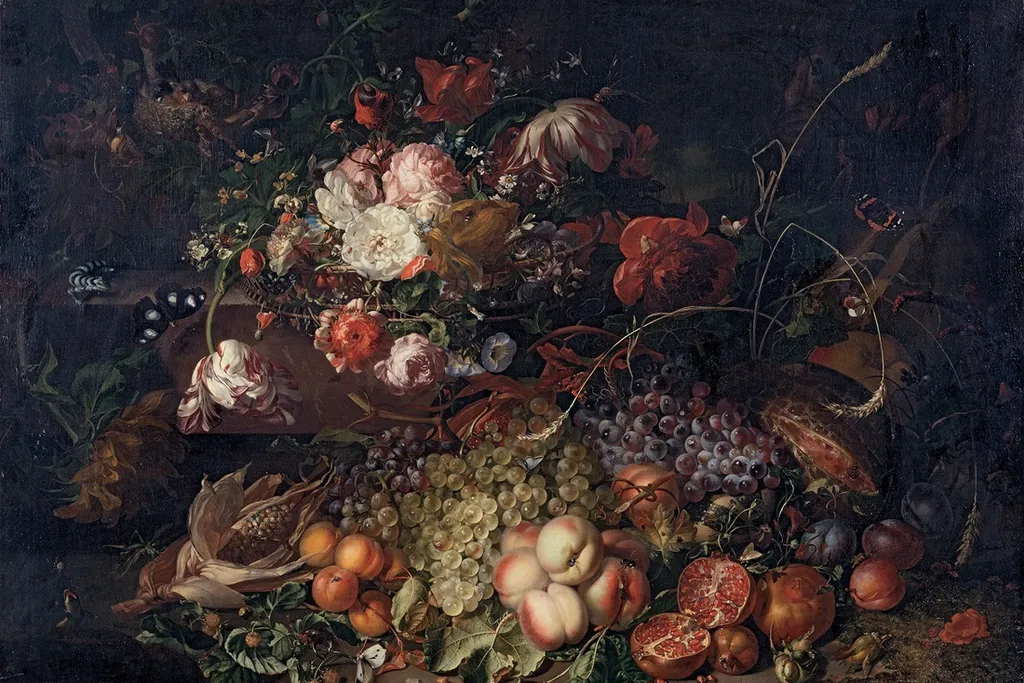
WWW.SMITHSONIANMAG.COM
See the Flower Paintings of Rachel Ruysch, Whose Stunning Still Lifes Are Finally Getting the Attention They Deserve
Art Meets Science
See the Flower Paintings of Rachel Ruysch, Whose Stunning Still Lifes Are Finally Getting the Attention They Deserve
The Dutch “old mistress” was renowned in her own lifetime. But since her death 275 years ago, her legacy has been largely forgotten
Flowers and Fruit in a Forest, Rachel Ruysch, 1714
Toledo Museum of Art / Städtische Kunstsammlungen & Museen Augsburg
In the 17th century, Holland was in bloom. Following a bout of “tulipmania” in the 1630s, it became fashionable to visit the Hortus Botanicus, Amsterdam’s botanical garden, to catch a glimpse of a world full of flora, made accessible to the Dutch public after years of colonial expeditions.
Exotic flowers captured the attention of the art world, too. No Dutch flower painter was more renowned in her time than Rachel Ruysch, whose exquisite still lifes sold for even more than masterpieces by contemporaries like Rembrandt.
But while she found great fame and fortune in her lifetime, Ruysch’s legacy declined after her death in 1750.
While other old masters have graced the collections of the world’s most celebrated art museums, no North American museum owned a Ruysch until 1956, when the Toledo Museum of Art (TMA) bought Flower Still Life (1716-20).
“Despite her exceptional career, Ruysch’s contributions to art history have been underexplored,” Robert Schindler, a curator at the museum, says in a statement.
But thanks to Schindler, art historians and museumgoers will get a chance to learn more about Ruysch’s work. The TMA is hosting Ruysch’s first ever monographic exhibition. Titled “Rachel Ruysch: Nature Into Art,” the show opened on April 12 and will be on view until July 27.
Flowers in a Glass Vase, Rachel Ruysch, 1704
Toledo Museum of Art / Detroit Institute of Arts
With more than 100 loans from museums and private collections around the world, the exhibition features nearly 50 Ruysch paintings, alongside illustrated books, drawings and botanical and zoological specimens.
“Through this exhibition, we aim to shine a spotlight on her remarkable achievements and trace her illustrious career while exploring the rich connections in her work between art and science during the Scientific Revolution,” Schindler explains in the statement.
Science, after all, had been a dominant influence throughout Ruysch’s life. Born in the Hague in 1664, Ruysch was the eldest daughter of Frederik Ruysch, a prominent botanist and anatomist.
Her father encouraged her artistic ambitions by placing her under the apprenticeship of Willem van Aelst, a still life specialist.
Ruysch’s paintings exhibit a careful attention to detail, both in her keen observation of flowers and her deliberate brushstrokes. Masterpieces like Flowers and Fruit in a Forest (1714) display an impressive dedication to realism. Grapes look like grapes. A split-open pomegranate shows off its ruby arils. Some flowers droop downwards while others open proudly.As the Scientific Revolution spread across Europe, artists became increasingly devoted to realism in still life paintings of plants and flowers. As Thor Mednick, an art historian at the University of Toledo, tells the Toledo Blade’s Lillian King, it was “a moment when art and science were actually seen as equally important pursuits in what was generally known as natural philosophy. There was this feeling that art was a scientific intellectual pursuit along with the other disciplines.”
The exhibition features Ruysch’s only surviving drawing—a detailed illustration of a Surinam toad that Schindler discovered in the archives of the Royal Society of London.
“This [drawing] is the only time that Ruysch doesn’t use plants as her essential motif,” Schindler explains to Artnet’s Katie White. “Instead, it’s essentially a portrait of a toad, and situates her in the science of the time.”
Ruysch’s chosen subjects also reflect rigid gender norms that dictated which artistic genres women artists were able to pursue.
“History painting, which includes biblical, historical and mythological scenes, was at the top,” Schindler tells Artnet. “Then portraiture, and, at the bottom, still life painting.” History painting required artists to paint nude models, which women weren’t allowed to do.
A 1692 portrait of Rachel Ruysch painted by Ruysch and Michiel van Musscher
Toledo Museum of Art / Metropolitan Museum of Art
Even within these strictures—and even while caring for 11 children—Ruysch excelled. “Her fame in her lifetime was extraordinary,” Megan Reddicks Pignataro, a curatorial research associate at the museum, tells BG Independent News’ David Dupont.
The exhibition also features the works of her younger sister, Anna Ruysch, as well as other pioneering women artists who painted botanical scenes, including Maria Sibylla Merian, Johanna Helena Herolt and Alida Withoos.
But the blooming heart of the exhibition remains Ruysch. “Rachel Ruysch: Nature Into Art” is a long overdue celebration of her remarkable career.
“It’s been such a great project to work on. I’m hoping we’ve found ways to get that across to visitors and open the door for more scholarship,” Schindler tells Artnet. “There’s so much more to discover.”
“Rachel Ruysch: Nature Into Art” is on view at the Toledo Museum of Art in Ohio through July 27, 2025.
Get the latest stories in your inbox every weekday.
0 Commentarios
0 Acciones
37 Views


